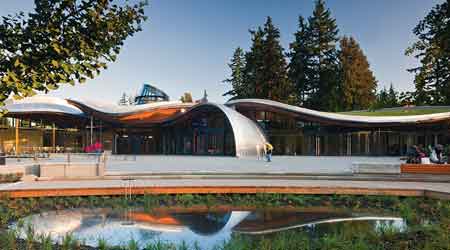 The shape of the VanDusen Botanical Garden Visitor Centre in Vancouver is inspired by the shape of a flower. Undulating vegetated roof “petals” seem to float above glass windows and curving walls made from rammed earth and concrete.Sharp & Diamond
The shape of the VanDusen Botanical Garden Visitor Centre in Vancouver is inspired by the shape of a flower. Undulating vegetated roof “petals” seem to float above glass windows and curving walls made from rammed earth and concrete.Sharp & Diamond Biophilia in Existing Buildings: Keeping the Momentum
Biophilic features don't have to be expensive or ornate. But they do need to be maintained. Facilities managers must be at the table during design to ensure biophilic elements make sense for long-term operations.
Unfortunately, most biophilic frameworks end at the design phase. But what happens to a biophilic building after it has been built? Who will care for the plants, maintain the water features, and respond to feedback from building employees? It is critical to think beyond design and extend through the operation and occupancy of the building to make the most of its biophilic features. A recent experience highlighted the importance of working with facility managers when designing biophilic spaces. The architect had proposed a beautiful natural wall feature but hadn’t fully considered the way the feature would wear over time and how users might damage it. Based on experience with similar non-biophilic features, the facility manager proposed a variety of changes that would make the feature longer lasting and easier to maintain.
Where possible, facility managers should be at the table when biophilic design decisions are being made to ensure the vision endures throughout the building’s life cycle. Facility managers provide the best vantage point for when biophilic elements should be introduced, improved, or maintained. They provide invaluable input on predicted challenges, ongoing expenses, and long-term value of biophilic elements. Because biophilic design is a relatively young field, tracking the results of innovative strategies and making changes as needed will be important in ensuring their success.
While the media tends to focus on grand visions of glass cloud forests and giant green walls, biophilic design doesn’t have to be expensive or ornate. In fact, it doesn’t have to be part of the design phase at all. While it’s easiest to implement integrated biophilic strategies at the start of a project, some of high-impact changes can be easily implemented throughout operations. Here are just a few examples:
- Add potted plants and flowers.
- Reconfigure spaces to maximize natural light and views to the outdoors.
- Create small spaces of refuge isolated with sound-absorbing furniture or partitions.
- Make space for a water feature.
- Hire a local artist to create a mural.
- Play gentle bird song in common areas.
- Organize outings to local parks or conservatories.
For more inspiration look through the International Living Future Institute's biophilic design case studies which highlight some of the healthiest, highest performing biophilic buildings in the world today. You can also think back to that serene place mentioned at the start of this article. What was it about this place that made you feel at peace? Let’s design and operate our built environment, the place we spend 90 percent of our time, more like the natural spaces that make us happier, healthier, and more human.
Paula Przybylski is sustainability consultant for stok, a sustainable design and consulting firm.
Related Topics:













